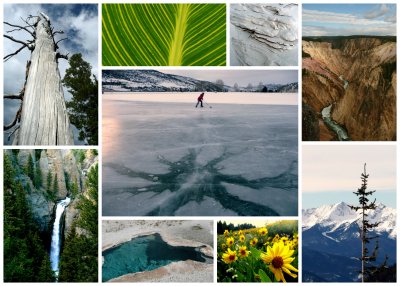Click here to visit the original post of Portraits of the Natural Brain by Dr. Cynthia Peng
Caption:
Center Neuron – formed from the varied colorings of cracks in ice
Top Spinal Column – tree trunk Corpus Callosum – banana leaf’s branching colorations represents fibers emanating from a central midline Cortical Layers – natural gradient of white sands Sulci & Gyri – canyon giving way to a river mimics the folding of the cortex
Bottom Cerebral Aqueduct – waterfall symbolizing cerebrospinal fluid flowing from 3rd ventricle to the spinal cord Ventricle – geothermal hot springs Astrocytes – starlike daisies Dendrite – evergreen overlooking the Continental Divide
Artist Statement: “Portraits of the Natural Brain”
It has been over a decade since I created this photo collage of parts of nature that resemble parts of the brain, depicting representations from neurons to neuroanatomical structures. My inspiration for creating this piece stemmed from the similarities between a neuron under the microscope and galaxies in the universe:
“One is only micrometers wide. The other is billions of light years across. One shows neurons in a mouse brain. The other is a simulated image of the universe. Together they suggest the surprisingly similar patterns found in vastly different natural phenomena.”
Nature and exploration of wilderness spaces has long been a treasured leisure activity since childhood. In my teens and early 20s, the nascent era of my fascination with neuroscience, my family took numerous trips to national parks, including Yellowstone, Grand Teton, White Sands, Rocky Mountain, and many more. Following in the footsteps of the great naturalists, artists, and photographers who have ventured before me, I was not only struck by the raw grandeur of the landscape but how curiously nature emulates itself. A neural structure only micrometers wide mimics shapes of organisms in the wilderness that are perceptible with the naked eye. Conversely, the awe-inspiring mammoth forms found in the wild are evocative of neural patterns a scientist would be interested in studying under a microscope. A decade later as a psychiatry resident, I am now looking at the inverse: how being in nature and greenspace positively impacts mental health. Perhaps just like interconnected neural circuits, things have come full circle.
Cynthia S. Peng is a PGY3 psychiatry resident at Brigham and Women’s Hospital, Harvard Medical School. Her interests are broadly at the intersection of medicine and the humanities, including photography, music, and narrative writing. Follow her on Twitter at @cynthiaspeng

